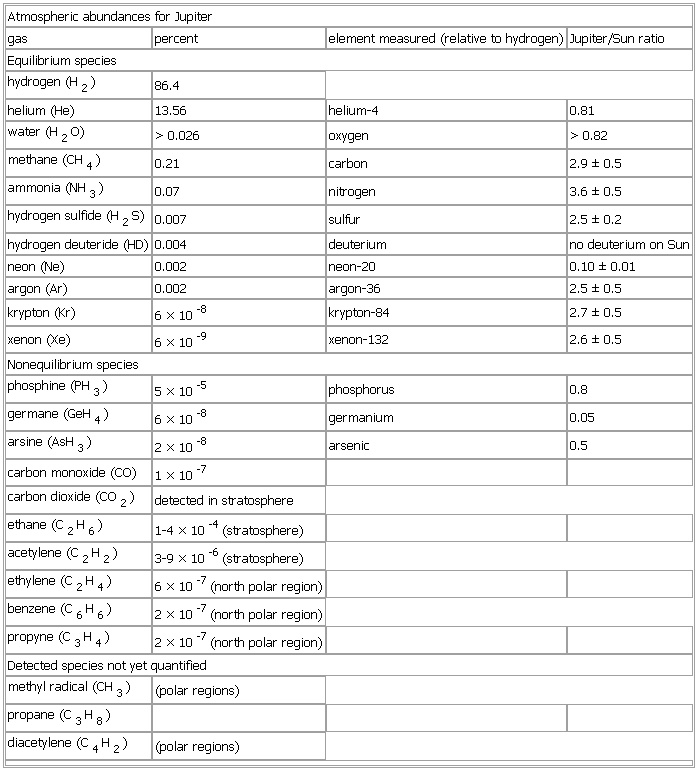Atmospheric abundances for Jupiter
- Atmospheric abundances for Jupiter
-
Atmospheric abundances for Jupiter
gas percent element measured (relative to hydrogen) Jupiter/Sun ratio
Equilibrium species
hydrogen (H2) 86.4
helium (
He) 13.56 helium-4 0.81
water (H2O) > 0.026 oxygen > 0.82
methane (
CH4) 0.21 carbon 2.9 ± 0.5
ammonia (
NH3) 0.07 nitrogen 3.6 ± 0.5
hydrogen sulfide (H2S) 0.007 sulfur 2.5 ± 0.2
hydrogen deuteride (
HD) 0.004 deuterium no deuterium on Sun
neon (
Ne) 0.002 neon-20 0.10 ± 0.01
argon (
Ar) 0.002 argon-36 2.5 ± 0.5
krypton (
Kr) 6 × 10
-8 krypton-84 2.7 ± 0.5
xenon (
Xe) 6 × 10
-9 xenon-132 2.6 ± 0.5
Nonequilibrium species
phosphine (
PH3) 5 × 10
-5 phosphorus 0.8
germane (
GeH4) 6 × 10
-8 germanium 0.05
arsine (
AsH3) 2 × 10
-8 arsenic 0.5
carbon monoxide (
CO) 1 × 10
-7 carbon dioxide (
CO2) detected in stratosphere
ethylene (C2H4) 6 × 10-7 (north polar region)
benzene (C6H6) 2 × 10-7 (north polar region)
propyne (C3H4) 2 × 10-7 (north polar region)
Detected species not yet quantified
propane (C3H8)
See as table:
* * *
Universalium.
2010.
Look at other dictionaries:
Jupiter — /jooh pi teuhr/, n. 1. Also called Jove. the supreme deity of the ancient Romans: the god of the heavens and of weather. Cf. Zeus. 2. Astron. the planet fifth in order from the sun, having an equatorial diameter of 88,729 mi. (142,796 km), a mean … Universalium
Jupiter — This article is about the planet. For other uses, see Jupiter (disambiguation). Jupiter … Wikipedia
Atmospheric reentry — refers to the movement of human made or natural objects as they enter the atmosphere of a planet from outer space, in the case of Earth from an altitude above the edge of space. This article primarily addresses the process of controlled reentry… … Wikipedia
Atmosphere of Jupiter — Cloud pattern on Jupiter in 2000 The atmosphere of Jupiter is the largest planetary atmosphere in the Solar System. It is mostly made of molecular hydrogen and helium in roughly solar proportions; other chemical compounds are present only in… … Wikipedia
New Frontiers program — For other uses, see New Frontier (disambiguation). The spacecraft New Horizons launched in 2006 towards Pluto The New Frontiers program is a series of space exploration missions being conducted by NASA with the purpose of researching several of… … Wikipedia
Titan (moon) — Titan Titan in 2005 by Cassini spacecraft Discovery Discovered by Christiaan Huygens … Wikipedia
chemical element — Introduction also called element, any substance that cannot be decomposed into simpler substances by ordinary chemical processes. Elements are the fundamental materials of which all matter is composed. This article considers the… … Universalium
Uranus — This article is about the planet. For other uses, see Uranus (disambiguation). Uranus … Wikipedia
Abundance of the chemical elements — Estimated proportions of matter, dark matter and dark energy in the universe. Only the fraction of the mass and energy in the universe labeled atoms is composed of chemical elements. The abundance of a chemical element measures how relatively… … Wikipedia
Uranus — /yoor euh neuhs, yoo ray /, n. 1. Astron. the planet seventh in order from the sun, having an equatorial diameter of 32,600 miles (56,460 km), a mean distance from the sun of 1,784 million miles (2,871 million km), a period of revolution of 84.07 … Universalium

